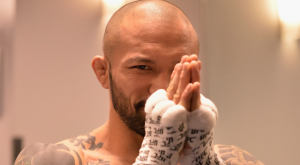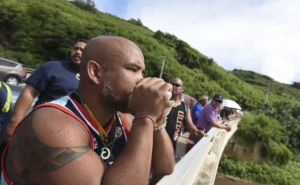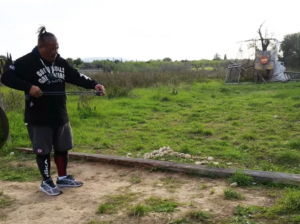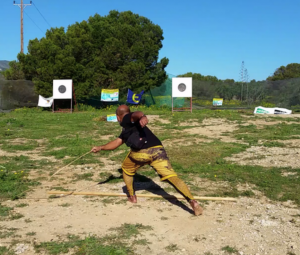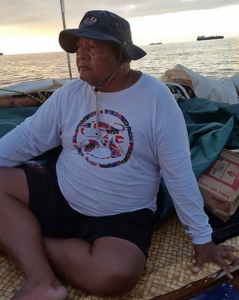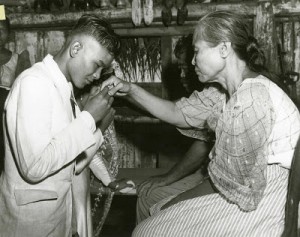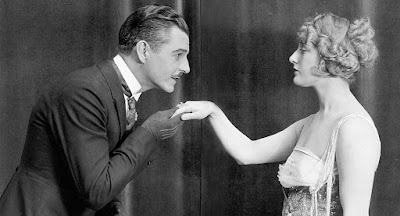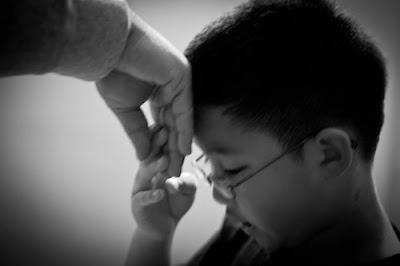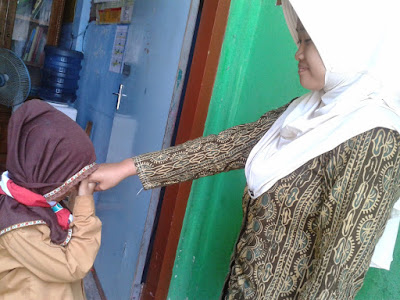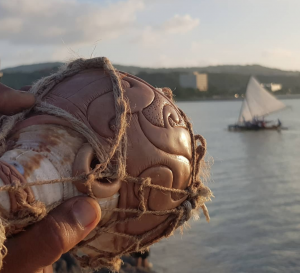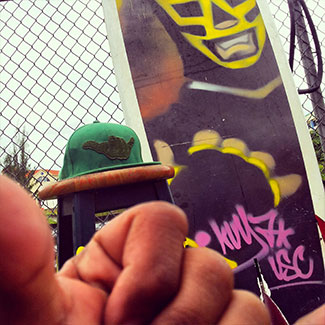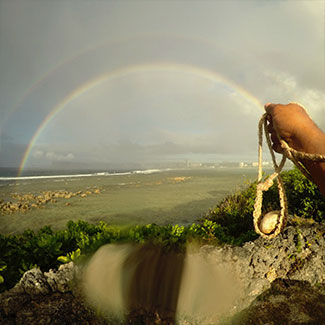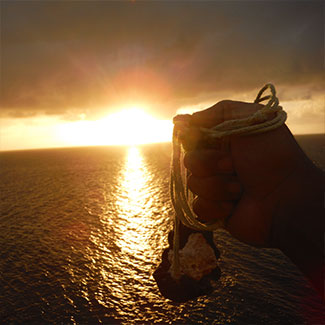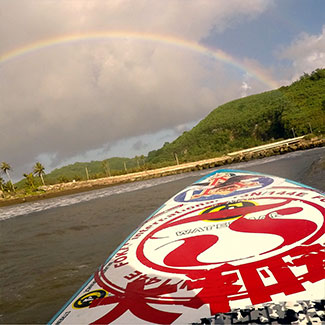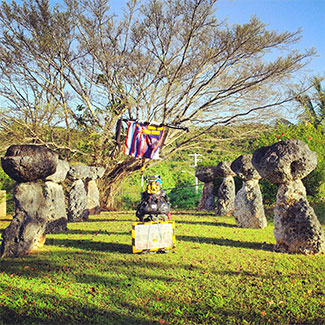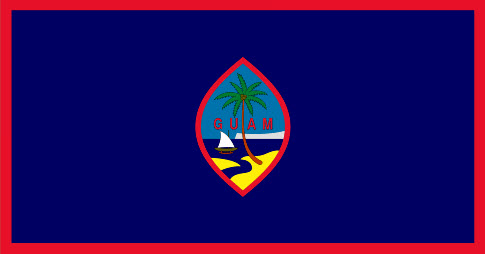Handcrafted:
May 17, 2019 by admin
Filed under Special Forces
Not many people know this, but most of Fokai;s Bali made products are handcrafted. Very slight occasional size differences are only as inevitable as human error. Heres a quickview of a piece of the process before the final touches
INTERSCHOILASTIC SLINGING via KUAM
April 30, 2019 by admin
Filed under Special Forces
News
10 schools compete in sling event
Tuesday, April 30th 2019, 1:58 PM ChST
By Dave Delgado
Image
10 schools were represented at the first of many sling competitions to hopefully be part of GDOE and their Chamorro activities. The slinging went down at the Tiyan Softball Field with targets set up at different distances for elementary, middle and high school participants.
Tony Diaz, the Event Organizer, said, “They’re here because they believe in this sport and they want to participate and they are having a blast as you can see. It’s really a pleasure to see them walk in the footsteps of our ancestors.”
For safety issues, Diaz created stones that were suitable for the young competitors to use. They were replicas of what our ancestors used. “They are actually made out of silicone and corn starch. We shaped them into the sling stones that we know that our ancestors used. It’s a safety issue and we certainly can’t use stones here because we have students and kids. So for safety reasons we went ahead and used that type of projectile,” he said.
The slings used for the competition were made out of paracord and done by students and faculty from the various schools.
Diaz added, “There are certain variations and certain types of materials that they are using. Mainly paracord and other types of strings like fiber and strings like twine maybe and some have probably have gone as far as the Pago bark fiber that they make their strings with.”
Diaz says the long term goal is to one day have slinging in the Micronesian Games and to also open up the sport to all ages.
“We would like to also see this also become an interscholastic sport, kind of what we do with volleyball, basketball and things in that nature in those sports. This is our sport this is our culture and this is what we know our ancestors did. It is also in the history books. The kids are really having a blast and they like this sport and I think it’s enough to make it a sport as far as I’m concerned,” he said.
What is a sling?
February 23, 2019 by admin
Filed under Special Forces
 What is a sling?
What is a sling?
The sling was likely mankind’s first, true projectile weapon. It generally consists of two cords and a pouch. These cords are held in one hand and a projectile is placed in the pouch. The length of the sling provides greater mechanical advantage than one’s arms. Projectiles can be slung over 1500 feet (450m) at speeds exceeding 250 miles per hour (400 kph). The sling is unique in that the movement of the weapon is merely an extension of the user’s body. The power and accuracy of the weapon is not by technological means, but rather user skill. The connection between slinger and sling is an intimate one.
There are many historical sources which describe the sling’s extraordinary performance characteristics. Its main competitor, the bow, had both a shorter range and slower rate of fire. Additionally, dozens of historical sources note the remarkable accuracy of a sling in trained hands. Although use of the weapon diminished after the fall of the Roman Empire, the weapon’s supremacy as the premier, personal, long-range weapon was not supplanted until the 15th century. Ultimately, changes in society, technology and military tactics rendered the sling ineffective in large-scale, organized warfare. The sling continues to be used in various smaller conflicts and by enthusiasts to this day.
Kid Yamamoto: a Hero’s Hero. RIP KID!
September 23, 2018 by admin
Filed under Special Forces
Japanese legend Norifumi Yamamoto, the one-time pound-for-pound king, passed away this week from cancer.
The bafflingly named Hero’s was launched in 2005 as an offshoot of the great kickboxing promotion, K-1. An ultra successful crossover event with PRIDE FC in 2002 had left the K-1 big wigs thinking that they had better start working their way into this mixed martial arts malarkey and so Hero’s became K-1’s MMA arm.
Revisiting the run of Hero’s events it is strange to realize that the company was only around for a couple of years—from March 2005 until December 2007. DREAM lasted longer, PRIDE had been going for almost a decade when Hero’s started up and ended the same year, and even the youngest Japanese promotion, Rizin, has outlasted Hero’s at this point. Yet in those three years, Hero’s gave us some of the more memorable moments in Japanese MMA.
Kazushi Sakuraba abandoned PRIDE—the house that he had built—in order to join Hero’s, returning from the brink of defeat against Kestutis Smirnovas and losing in one of the sketchiest bouts of all time to a greased up Yoshihiro Akiyama. Genki Sudo found a home in Hero’s and was able to employ more and more theater in his legendary entrances to the point that he eventually abandoned fighting altogether and formed a successful pop group. Theater and narratives are a large part of fighting, but in terms of raw talent there was one man who stood out from the herd in Hero’s and whose highlight reels could be pulled up on YouTube at any point to convince friends that there was a future to this MMA thing: Norifumi “Kid” Yamamoto.
A Bolt from the Blue
By the time that Hero’s announced its first grand prix, Yamamoto had already established something of a reputation as Japanese MMA’s bad boy—hitting opponents late after having knocked them out and living a dramatic life outside of the ring. He had dabbled in kickboxing in 2004 with a victory over Takehiro Murahama and a surprisingly competitive and dramatic fight with the great Masato on New Year’s Eve. But as far as MMA went, there was an awful lot of hype and fans just weren’t sure they had seen enough to justify it yet.
Yamamoto had competed successfully in Shooto but had never won a Shooto title—pretty much a rite of passage for a Japanese MMA prospect. Scouted by K-1, Yamamoto found himself in a similar position to Tenshin Nasukawa’s modern position in Rizin—the company liked him but weren’t finding him suitable opponents or building a division for him to compete in. Yamamoto went from fighting the formidable Jeff Curran (16-5-1) in Icon Sport in May of 2003 to taking three fights against opponents with no MMA record in K-1 through to 2005.
Kid was a potential star, but fighting nobodies wasn’t going to get him anywhere and he knew this. So when Hero’s announced their middleweight grand prix, Yamamoto decided to take a crack at Hero’s’s first belt. Hero’s followed the Japanese tradition of making up its own weightclasses that deliberately didn’t conform with anyone else’s, so middleweight was in fact 75 kilograms or 165 pounds. This meant that Hero’s could enlist the services of the excellent lightweights Genki Sudo and Caol Uno to legitimize their first tournament. The tournament would have been even better had Joachim Hansen not been poached by PRIDE just before it began. Kid Yamamoto, however, was not a respected lightweight—he was a bantamweight at best who floated up to featherweight to get fights.
As far as ballsy moves go, Yamamoto’s decision to enter the Hero’s middleweight grand prix was one of the ballsiest in MMA. Though he was 5’4″ on a good day, the tournament quickly stopped being about Yamamoto being undersized and became about the rest of the fighters being underpowered.
The Yamamoto clan are now a wrestling dynasty: the father, Ikuei Yamamoto had competed in the Munich Olympics, the elder sister Miyuu is a three time world champion, and Norifumi’s younger sister, Seiko is a four time world champion who achieved a bronze in the ADCC no gi grappling world championships eleven years after her last world title in wrestling. While Norifumi missed out on a serious wrestling career, he was able to put his talent to use in learning the MMA game and also entered The Contenders, a grappling tournament wherein he bested judo submissions wizard Koji Komuro. Throughout the 2005 grand prix, fans were treated to numerous instances of Yamamoto throwing around larger opponents in styles that didn’t always make sense to the eyes. The sight of Yamamoto holding Royler Gracie’s toes about an inch off the floor in a standing guillotine will always be hilarious.
We can never pretend that Yamamoto was a striking savant—his game was the leaping right hook and some hard kicks and that was about it. But what Yamamoto did have was ridiculous speed. Almost everyone he fought would inevitably try to kick or knee him in the head and he would return with his right hook—often wound up from far behind him—before they could get their foot back to the ground.
On the first night of the Hero’s grand prix, Yamamoto knocked Royler Gracie stiff with a right hook to the jaw, then took on Japanese MMA legend Caol Uno in the second round, forcing a TKO due to cuts over Uno’s left eye from stiff right straights and hooks. Genki Sudo had worked through his half of the bracket, submitting Kazuyuki Miyata and Hiroyuki Takaya and this set up a Yamamoto-Sudo final at K-1 Premium Dynamite 2005. The bout headlined K-1’s year-ending show at the Osaka Dome on a card containing kickboxing legends like Ernesto Hoost and Semmy Schilt. After a very tentative few minutes, Yamamoto finally caught the grappling savant with a right hook as he came in and sent him to the mat. Flurrying for the finish, Yamamoto’s finest moment was somewhat undercut by a premature stoppage. Yet the accomplishment has never been replicated: a fighter going up two weightclasses to run through a tournament with two fights in one night, stopping each opponent.
Yamamoto’s career peaked with his victory in the 2005 grand prix, but injuries and strange matchmaking left us with a great many unanswered questions. There was occasional talk about a possible match up between Yamamoto and PRIDE’s lightweight king, Takanori Gomi. Others wanted to see Yamamoto in with Urijah Faber, a trailblazer in the featherweight class in the United States. But while those match ups were complicated by the fighters being under different promotions, Hero’s did a bad job of finding Yamamoto opponents even under the same banner. The Genki Sudo rematch never happened and Sudo retired in 2007, but perhaps more surprisingly Gesias ‘JZ’ Cavalcante won the two subsequent Hero’s tournaments in Yamamoto’s division and that eagerly anticipated fight never materialized. Yamamoto had proven that he was the star and after starching Kazuyuki Miyata with the finest and quickest flying knee ever to grace MMA, Yamamoto wanted to return to his natural weight class.
Try to take note of where Yamamoto’s right foot last touches the mat before the knee, and then where it lands afterwards. There are some who attest that Yamamoto might have been the greatest raw athlete to ever compete in MMA. Watching Yamamoto hammer the heavy bag is one of the more impressive sights this writer has seen in the gym.
Hero’s best efforts were pretty bad. At featherweight, Yamamoto was matched against the 0-0-0 wrestler, Istvan Majoros in a fight so lopsided that he felt bad about punching the guy.
Another interesting quirk of Yamamoto’s game, he was a murderer with knees to the body out of the double collar tie, even against much taller opponents like Caol Uno.
Then on the same night that JZ Cavalcante won the 2007 grand prix, Yamamoto fought the 1-1 Bibiano Fernandes in the co-main event—his first fight at bantamweight. Fernandes went on to become something very special indeed over the coming years, but it was a truly weird piece of matchmaking at the time.
The last great showing Yamamoto had came against the formidable Rani Yahya on the last night of 2009. Yahya then had a 12-3 MMA record, had won gold at ADCC earlier in the year, and was fresh off a decision loss to Chase Beebe for the WEC bantamweight championship. Yamamoto, looking more polished and thoughtful, set to work with hard kicks and counter punches. He dug body shots with his left hand and dipped out after his right hooks. It was one of Yamamoto’s smoothest performances in the ring, and he handed Yahya his first knockout loss in the second round.
A surprisingly smooth and measured Yamamoto.
Then Yamamoto injured his knee and was out for two years. The Kid of old never came back. He fought Joe Warren in the opening round of the DREAM featherweight grand prix (back up a weight class) on his return in 2009 but lost a split decision to the American wrestler. A decision loss to the unremarkable Masanori Kanehara followed wherein Yamamoto was dropped on his face. His feet were so much slower and it was becoming clear that his chin was not up to it any more. In almost all of his remaining fights Yamamoto’s chin looked shaky and he just didn’t seem to have that electricity that made him impossible to look away from in 2005. In a passing of the torch moment, Yamamoto—MMA’s most notorious little man—met Demetrious Johnson in February 2011 and was handily outworked. The men Yamamoto was struggling against by the very end of his career likely wouldn’t have laid a glove on him at his best, but that is the nature of fighting.
In truth, to many fans Yamamoto remains a case of untested potential similar to the late Kevin Randleman but with a far more successful run in the fights he did have. But even as his abilities waned, Kid Yamamoto impacted the future of Japanese MMA even as it was entering a sleepy, post-PRIDE hibernation. Yamamoto had built his own gym to train on his own terms and as his own career wound down, successful youngsters began to trickle out of the small Yamamoto Sports Academy: the respectable Issei Tamura, the wily Kotetsu Boku, and the hot young prospect Yusuke Yachi to name a few. Kyoji Horiguchi was a quiet gym rat at the YSA through his teens, often found behind the front desk or teaching the kids wrestling classes, and now he is the best fighter Japan has perhaps ever produced. If you have any doubt of Yamamoto’s direct influence on Horiguchi, watch Horiguchi’s Shooto run wherein he looks the spitting image of Kid, leaping in behind lead hooks over and over again. Even years before Horiguchi began competing, Killer Bee gym (as it was in its previous incarnation) was the training grounds of the fearsome Akira Kikuchi—often regarded as one of the big “what ifs” of Japanese MMA. Yamamoto’s elder sister Miyuu and her son—Kid’s nephew, Erson, also fight out of the YSA. Rizin undoubtedly has a lot to thank Norifumi Yamamoto for, even if he never fought under their banner.
As he became more of an occasional competitor, Yamamoto also continued to explore his love of art and tattoos, coming into each bout more beautifully decorated than the last, with stunning shorts to match. In a sport full of atrocious ink with almost half of the fighters you see having their own name tattooed across their back lest they forget, Yamamoto’s ink stood out as genuine art. Strangely enough Yamamoto also began working on a curry restaurant in his semi-retirement, hilariously named Curry Shower, but just as the Kid was starting his second act he was cut down by cancer.
For the past few years, we have all been writing about Kid Yamamoto as an old man because in the fight game he was. One of the guilty pleasures of any fight writer is cracking wise about “old timers” and then being forced to eat crow if they can turn back the clock for one night. That’s the way it is supposed to be: 40-year-old men aren’t supposed to be able to keep up with 25-year-old kids. The heartbreaking thing is that in any other way of looking at it, in any other aspect of life, Kid Yamamoto was not an old man. He wasn’t even middle aged. The name ‘Kid’ had started to seem silly by the time Yamamoto hit 30, but to Miyuu Yamamoto he was still just her little brother, and to Ikuei Yamamoto, I’m sure Norifumi was still his baby boy.
Sling (weapon) from Wikipedia
September 18, 2018 by admin
Filed under Special Forces
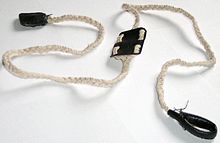
Home-made sling
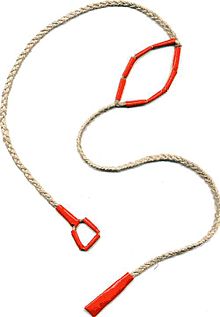
Home-made sling
A sling is a projectile weapon typically used to throw a blunt projectile such as a stone, clay, or lead “sling-bullet”. It is also known as the shepherd’s sling. Someone who specialises in using slings is called a slinger.
A sling has a small cradle or pouch in the middle of two lengths of cord. The sling stone is placed in the pouch. The middle finger or thumb is placed through a loop on the end of one cord, and a tab at the end of the other cord is placed between the thumb and forefinger. The sling is swung in an arc, and the tab released at a precise moment. This frees the projectile to fly to the target. The sling essentially works by extending the length of a human arm, thus allowing stones to be thrown much farther than they could be by hand.
The sling is inexpensive and easy to build. It has historically been used for hunting game and in combat. Film exists of Spanish Civil War combatants using slings to throw grenades over buildings into enemy positions on the opposite street. Today the sling is of interest as a wilderness survival tool and an improvised weapon.[1]
The sling in antiquity
Origins
The sling is an ancient weapon known to Neolithic peoples around the Mediterranean, but is likely much older. It is possible that the sling was invented during the Upper Paleolithic at a time when new technologies such as the spear-thrower and the bow and arrow were emerging.
With the exception of Australia, where spear throwing technology such as the woomera predominated, the sling became common all over the world, although it is not clear whether this occurred because of cultural diffusion or as an independent invention.
Archaeology
Whereas sling-bullets are common finds in the archaeological record, slings themselves are rare. This is both because a sling’s materials are biodegradable and because slings were lower-status weapons, rarely preserved in a wealthy person’s grave.
The oldest-known surviving slings—radiocarbon dated to ca. 2500 BC—were recovered from South American archaeological sites located on the coast of Peru. The oldest-known surviving North American sling—radiocarbon dated to ca. 1200 BC—was recovered from Lovelock Cave, Nevada.[2]
The oldest known extant slings from the Old World were found in the tomb of Tutankhamen, who died about 1325 BC. A pair of finely plaited slings were found with other weapons. The sling was probably intended for the departed pharaoh to use for hunting game.[3]
Another Egyptian sling was excavated in El-Lahun in Al Fayyum Egypt in 1914 by William Matthew Flinders Petrie, and now resides in the Petrie Museum of Egyptian Archaeology—Petrie dated it to about 800 BC. It was found alongside an iron spearhead. The remains are broken into three sections. Although fragile, the construction is clear: it is made of bast fibre (almost certainly flax) twine; the cords are braided in a 10-strand elliptical sennit and the cradle seems to have been woven from the same lengths of twine used to form the cords.[4]
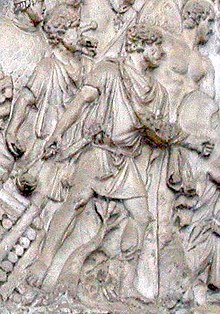
Slingers on Trajan’s Column.
Ancient representations
Representations of slingers can be found on artifacts from all over the ancient world, including Assyrian and Egyptian reliefs, the columns of Trajan[5] and Marcus Aurelius, on coins and on the Bayeux Tapestry.
The oldest representation of a slinger in art may be from Çatalhöyük, from approximately 7,000 BC, though it is the only such depiction at the site, despite numerous depictions of archers.[6]
Written history

Ancient Greek lead sling bullets with a winged thunderbolt molded on one side and the inscription “?????” (Dexai) meaning “take that” or “catch” on the other side, 4th century BC, from Athens, British Museum.[7]
The sling is mentioned by Homer[8] and by other Greek authors. Xenophon in his history of the retreat of the Ten Thousand, 401 BC, relates that the Greeks suffered severely from the slingers in the army of Artaxerxes II of Persia, while they themselves had neither cavalry nor slingers, and were unable to reach the enemy with their arrows and javelins. This deficiency was rectified when a company of 200 Rhodians, who understood the use of leaden sling-bullets, was formed. They were able, says Xenophon, to project their missiles twice as far as the Persian slingers, who used large stones.[9]
Ancient authors seemed to believe, incorrectly, that sling-bullets could penetrate armour, and that lead projectiles, heated by their passage through the air, would melt in flight.[10][11] In the first instance, it seems likely that the authors were indicating that slings could cause injury through armour by a percussive effect rather than by penetration. In the latter case we may imagine that they were impressed by the degree of deformation suffered by lead sling-bullet after hitting a hard target.[12]
Various ancient peoples enjoyed a reputation for skill with the sling. Thucydides mentions the Acarnanians and Livy refers to the inhabitants of three Greek cities on the northern coast of the Peloponnesus as expert slingers. Livy also mentions the most famous of ancient skillful slingers: the people of the Balearic Islands. Of these people Strabo writes: And their training in the use of slings used to be such, from childhood up, that they would not so much as give bread to their children unless they first hit it with the sling.[13]
The late Roman writer Vegetius, in his work De Re Militari, wrote:
- Recruits are to be taught the art of throwing stones both with the hand and sling. The inhabitants of the Balearic Islands are said to have been the inventors of slings, and to have managed them with surprising dexterity, owing to the manner of bringing up their children. The children were not allowed to have their food by their mothers till they had first struck it with their sling. Soldiers, notwithstanding their defensive armour, are often more annoyed by the round stones from the sling than by all the arrows of the enemy. Stones kill without mangling the body, and the contusion is mortal without loss of blood. It is universally known the ancients employed slingers in all their engagements. There is the greater reason for instructing all troops, without exception, in this exercise, as the sling cannot be reckoned any encumbrance, and often is of the greatest service, especially when they are obliged to engage in stony places, to defend a mountain or an eminence, or to repulse an enemy at the attack of a castle or city.[14]
According to description of Procopius, the sling had an effective range further than a Hun bow and arrow. In his book Wars of Justinian, he recorded the felling of a Hun warrior by a slinger:
- Now one of the Huns who was fighting before the others was making more trouble for the Romans than all the rest. And some rustic made a good shot and hit him on the right knee with a sling, and he immediately fell headlong from his horse to the ground, which thing heartened the Romans still more[15]
Biblical accounts
The sling is mentioned in the Bible, which provides what is believed to be the oldest textual reference to a sling in the Book of Judges, 20:16. This text was thought to have been written about 6th century BC,[16] but refers to events several centuries earlier.
The Bible provides a famous slinger account, the battle between David and Goliath from the First Book of Samuel 17:34-36, probably written in the 7th or 6th century BC, describing events having occurred around the 10th century BC. The sling, easily produced, was the weapon of choice for shepherds fending off animals. Due to this, the sling was a commonly used weapon by the Israelite militia.[17] Goliath was a tall, well equipped and experienced warrior. In this account, the shepherd David convinces Saul to let him fight Goliath on behalf of the Israelites. Unarmoured and equipped only with a sling, 5 smooth rocks, and his staff; David defeats the champion Goliath with a well-aimed shot to the head.
Use of the sling is also mentioned in Second Kings 3:25, First Chronicles 12:2, and Second Chronicles 26:14 to further illustrate Israelite use.
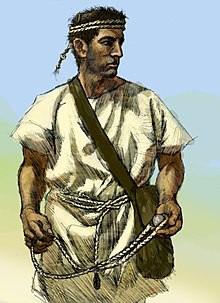
An artistic depiction of a slinger from the Balearic islands, famous for the skill of its slingers.
Combat
Ancient peoples used the sling in combat—armies included both specialist slingers and regular soldiers equipped with slings. As a weapon, the sling had several advantages; a sling bullet lobbed in a high trajectory can achieve ranges in excess of 400 metres (1,300 ft).[18] Modern authorities vary widely in their estimates of the effective range of ancient weapons. A bow and arrow could also have been used to produce a long range arcing trajectory, but ancient writers repeatedly stress the sling’s advantage of range. The sling was light to carry and cheap to produce; ammunition in the form of stones was readily available and often to be found near the site of battle. The ranges the sling could achieve with molded lead sling-bullets was surpassed only by the strong composite bow.
Caches of sling ammunition have been found at the sites of Iron Age hill forts of Europe; some 22,000 sling stones were found at Maiden Castle, Dorset.[19] It is proposed that Iron Age hill forts of Europe were designed to maximise the effective defense of slingers.
The hilltop location of the wooden forts would have given the defending slingers the advantage of range over the attackers, and multiple concentric ramparts, each higher than the other, would allow a large number of men to create a hailstorm of stone. Consistent with this, it has been noted that defenses are generally narrow where the natural slope is steep, and wider where the slope is more gradual.
Construction
A classic sling is braided from non-elastic material. The traditional materials are flax, hemp or wool; those of the Balearic islanders were said to be made from a type of rush. Flax and hemp resist rotting, but wool is softer and more comfortable.
Braided cords are used in preference to twisted rope, as a braid resists twisting when stretched. This improves accuracy.[20]
The overall length of a sling can vary significantly; a slinger may have slings of different lengths, a longer sling being used when greater range is required. A length of about 61 to 100 cm (2.00 to 3.28 ft) would be typical.
At the centre of the sling, a cradle or pouch is constructed. This may be formed by making a wide braid from the same material as the cords or by inserting a piece of a different material such as leather. The cradle is typically diamond shaped (although some take the form of a net,) and will fold around the projectile in use. Some cradles have a hole or slit that allows the material to wrap around the projectile slightly, thereby holding it more securely.
At the end of one cord (called the retention cord) a finger-loop is formed.[citation needed] At the end of the other cord (the release cord,) it is a common practice to form a knot or a tab.[citation needed] The release cord will be held between finger and thumb to be released at just the right moment, and may have a complex braid to add bulk to the end. This makes the knot easier to hold, and the extra weight allows the loose end of a discharged sling to be recovered with a flick of the wrist.[citation needed]
Polyester is an excellent material for modern slings, because it does not rot or stretch and is soft and free of splinters.[citation needed]
Modern slings are begun by plaiting the cord for the finger loop in the center of a double-length set of cords.[citation needed] The cords are then folded to form the finger-loop. The cords are plaited as a single cord to the pocket. The pocket is then plaited, most simply as another pair of cords, or with flat braids or a woven net. The remainder of the sling is plaited as a single cord, and then finished with a knot. Braided construction resists stretching, and therefore produces an accurate sling.[citation needed]
Ammunition
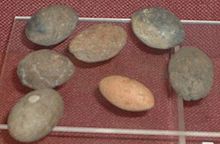
Sling-bullets of baked clay and stone found at Ham Hill Iron Age hill fort.
The simplest projectile was a stone, preferably well-rounded. Suitable ammunition is frequently from a river. The size of the projectiles can vary dramatically, from pebbles massing no more than 50 grams (1.8 oz) to fist-sized stones massing 500 grams (18 oz) or more.
Projectiles could also be purpose-made from clay; this allowed a very high consistency of size and shape to aid range and accuracy. Many examples have been found in the archaeological record.
The best ammunition was cast from lead. Leaden sling-bullets were widely used in the Greek and Roman world. For a given mass, lead, being very dense, offers the minimum size and therefore minimum air resistance. In addition, leaden sling-bullets are small and difficult to see in flight.
In some cases, the lead would be cast in a simple open mould made by pushing a finger or thumb into sand and pouring molten metal into the hole. However, sling-bullets were more frequently cast in two part moulds. Such sling-bullets come in a number of shapes including an ellipsoidal form closely resembling an acorn – this could be the origin of the Latin word for a leaden sling-bullet: glandes plumbeae (literally leaden acorns) or simply glandes (meaning acorns, singular glans).
Other shapes include spherical and (by far the most common) biconical, which resembles the shape of the shell of an almond nut or a flattened American football.
The ancients do not seem to have taken advantage of the manufacturing process to produce consistent results; leaden sling-bullets vary significantly. The reason why the almond shape was favoured is not clear: it is possible that there is some aerodynamic advantage, but it seems equally likely that there is some more prosaic reason, such as the shape being easy to extract from a mould, or the fact that it will rest in a sling cradle with little danger of rolling out.
Almond shaped leaden sling-bullets were typically about 35 millimetres (1.4 in) long and about 20 millimetres (0.79 in) wide, massing approximately 28 grams (0.99 oz). Very often, symbols or writings were moulded into lead sling-bullets. Many examples have been found including a collection of about 80 sling-bullets from the siege of Perusia in Etruria from 41 BC, to be found in the museum of modern Perugia. Examples of symbols include a stylised lightning bolt, a snake, and a scorpion – reminders of how a sling might strike without warning. Writing might include the name of the owning military unit or commander or might be more imaginative: “Take this,” “Ouch,” and even “For Pompey’s backside” added insult to injury, whereas dexai (“take this” or “catch!”)[7] is merely sarcastic.
Julius Caesar writes in De bello Gallico, book 5, about clay shot being heated before slinging, so that it might set light to thatch.[21]
“Whistling” bullets[edit]
Some bullets have been found with holes drilled in them. It was thought the holes were to contain poison. John Reid of the Trimontium Trust, finding holed Roman bullets excavated at the Burnswark hillfort, has proposed that the holes would cause the bullets to “whistle” in flight and the sound would intimidate opponents. The holed bullets were generally small and thus not particularly dangerous. Several could fit into a pouch and a single slinger could produce a terrorizing barrage. Experiments with modern replicas demonstrate they produce a whooshing sound in flight. [22]
The sling in medieval period
Europe
The Bayeux Tapestry of the 1070s portrays the use of slings in a hunting context. Frederick I, Holy Roman Emperor employed slingers during the Siege of Tortona in 1155 to suppress the garrison while his own men built siege engines.[23] On the Iberian peninsula, the Spanish and Portuguese infantry favoured it against light and agile Moorish troops. The staff sling continued to be used in sieges and the sling was used as a part of large siege engines.[24]
The Americas

A South American sling made of alpaca hair
The sling was known throughout the Americas.[25]
In the ancient Andean civilizations such as Inca Empire, slings were made from llama wool. These slings typically have a cradle that is long and thin and features a relatively long slit. Andean slings were constructed from contrasting colours of wool; complex braids and fine workmanship can result in beautiful patterns. Ceremonial slings were also made; these were large, non-functional and generally lacked a slit. To this day, ceremonial slings are used in parts of the Andes as accessories in dances and in mock battles. They are also used by llama herders; the animals will move away from the sound of a stone landing. The stones are not slung to hit the animals, but to persuade them to move in the desired direction.
The sling was also used in the Americas for hunting and warfare. One notable use was in Incan resistance against the conquistadors. These slings were apparently very powerful; in 1491: New Revelations of the Americas Before Columbus, historian Charles C. Mann quoted a conquistador as saying that an Incan sling “could break a sword in two pieces” and “kill a horse.”[26] Some slings spanned as much as 2.2 metres (86 in) long and weighed an impressive 410 grams (14.4 oz).[27][28]
Variants

Medieval traction trebuchet next to a staff slinger
Staff sling
The staff sling, also known as the stave sling, fustibalus (Latin), fustibale (French), consists of a staff (a length of wood) with a short sling at one end. One cord of the sling is firmly attached to the stave and the other end has a loop that can slide off and release the projectile. Staff slings are extremely powerful because the stave can be made as long as two meters, creating a powerful lever. Ancient art shows slingers holding staff slings by one end, with the pocket behind them, and using both hands to throw the staves forward over their heads.
The staff sling has a similar or superior range to the shepherd’s sling, and can be as accurate in practiced hands. It is generally suited for heavier missiles and siege situations as staff slings can achieve very steep trajectories for slinging over obstacles such as castle walls. The staff itself can become a close combat weapon in a melee. The staff sling is able to throw heavy projectiles a much greater distance and at a higher arc than a hand sling. Staff slings were in use well into the age of gunpowder as grenade launchers, and were used in ship-to-ship combat to throw incendiaries.
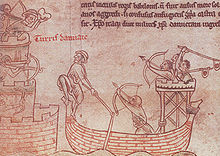
Medieval staff slingers (stern castle)
Kestros
The kestros (also known as the kestrosphendone, cestrus or cestrosphendone) is a sling weapon mentioned by Livy and Polybius. It seems to have been a heavy dart flung from a leather sling. It was invented in 168 BC and was employed by some of the Macedonian troops of King Perseus in Third Macedonian war.
Siege engines
The traction trebuchet was a siege engine which uses the power of men pulling on ropes or the energy stored in a raised weight to rotate what was, again, a staff sling. It was designed so that, when the throwing arm of the trebuchet had swung forward sufficiently, one end of the sling would automatically become detached and release the projectile. Some trebuchets were small and operated by a very small crew; however, unlike the onager, it was possible to build the trebuchet on a gigantic scale: such giants could hurl enormous rocks at huge ranges. Trebuchets are, in essence, mechanised slings.
Todaya

A Tibetan girl guarding a herd of goats slings a small rock.

Arab shepherd boy using a sling, c. 1900-1920, Jerusalem

Hooded youth rioters using slings
Traditional slinging is still practiced as it always has been in the Balearic Islands, and competitions and leagues are common. In the rest of the world, the sling is primarily a hobby weapon, and a growing number of people make and practice with them. In recent years ‘slingfests’ have been held in Wyoming, USA, in September 2007 and in Staffordshire, England, in June 2008.
According to the Guinness Book of World Records, the current record for the greatest distance achieved in hurling an object from a sling is 437.10 m (1,434 ft 1 in), using a 129.5 cm (51.0 in) long sling and a 52 g (1.8 oz) ovoid stone, set by Larry Bray in Loa, Utah, USA on 21 August 1981. The sling is of interest to athletes who desire to break distance records; the best modern material is a polyester twine (trade name Dacron)[citation needed].
The principles of the sling may find use on a larger scale in the future; proposals exist for tether propulsion of spacecraft, which functionally is an oversized sling to propel a spaceship.
The sling is used today as a weapon primarily by protestors, to launch either stones or incendiary devices, such as Molotov cocktails. Classic woolen slings are still in use in the Middle East by Arab nomads and Bedouins to ward off jackals and hyenas. International Brigades used slings to throw grenades during the Spanish Civil War. Similarly, the Finns made use of sling-launched Molotov cocktails in the Winter War against Soviet tanks. Slings were used during the various Palestinian riots against modern army personnel and riot police. They were also used in the 2008 disturbances in Kenya.[29][30]
Guam slingers compete in international tournament in Spain
September 14, 2018 by admin
Filed under Special Forces
About six months ago, Christian Sam Wirk of Austria turned the heads of our small group of stone slingers when he said there would be an international slinging tournament in Spain.
When he told us three months later that it coincided with the launch day of Chamorro month, that sealed the deal. As people of the only flag in the world that bears a sling stone, it was only proper that Guam be visible in the world’s largest stone-slinging event.
Since we felt ready enough and since slinging runs in our blood, we wanted to make a mark. We set the path. We reached out for support. Bound for Ireland and Spain, we aimed to sound the horns.
Thank you very much Tony Susuico of the Grasshopper Lounge , Paddy Quinian of FunkyTown, and JP at The Oar. Our journey through Ireland was epic on all accounts. Without their help, none of this would’ve been possible. It was a privilege to watch Guelu Rosario’s presentation on the Flying Proa in Ireland with our new seafaring friends in Croshaven. It was a great time to sling with him across the Emerald Isle, and it would be an honor to compete alongside him in an event considered the slinging world championships.
Still settling from an incredibly eventful 5 day adventure in Ireland on behalf of the Flying Proa — we barely made our flight through a tedious layover in London to eventually arrive Palma, Mallorca in Spain at 5:30 p.m. Feb. 25th.
Upon arriving at Hotel Horizon, we received information that there would be a smaller slinging tournament on the other side of the island at 11:00 a.m. the next morning. Neither of us had ever competed in a slinging competition before so we thought we’d give it a go. After a grossly underestimated and very expensive cab ride – we arrived dazed, confused and in the land of the lost in Chamorro time, 20 minutes late, to the Monasterio de Lluc. There we found triathlon and a whole array of other activities; but our hearts dropped when we were told that there was no slinging tournament available. After deciding, instead, to find ways to make the most of our 80 euro investment, we looked about 200m away from the premises to see two guys carrying slings. Apparently we arrived at the wrong destination. After a quick conversation, they pointed us further down the road where we arrived to see several people walking around selling hand made slings, competitors with sling club T-shirts, Officials with sling league vests, and generations and full families of slingers. Happily, we were convinced that we were at the world’s true mecca of sling culture and sport.
Arriving too late to compete, we stood out enough as spectators that we were invited by the event organizers to give slinging a try. They were excited when we replied by pulling our Guam-made slings out of our bags and became absolutely ecstatic when we revealed artifact sling stones that we also brought along from Guam for an around-the-world tour. After an electric and positive gathering over Guam’s artifact stones, the crowd goaded us to sling at the targets they had set for the competition. Guelu was on deck. I was right behind him. This was the time for Guam’s first slinging impression in Mallorca. Everyone was watching. They were happy to see that we knew well enough what we were doing and invited us to join them for the awards presentation at the center court of the festivities.
What happened after would set the pace for the trip. Guelu and I sounded the kulu shells we brought from Guam to congratulate a brand new friend that turned out to be a winner of the event.
This caught enough attention that in the process, we were introduced to Diego Camanas. The main pioneer of modern day Mallorcan slinging sport.
Diego was about 70 years old, and also a former multiple-time slinging champion. He, like everyone else there, had never heard of Guam. We were happy to change that. Thereafter we were invited and driven by some locals for target practice at their sling training ground in the nearby village of Inca. From the Pacific Ocean to the Mediterranean Sea—birds of a feather had flocked together and our trip of slinging and sharing culture in Mallorca officially took flight.
The people of Mallorca, Spain have been slinging stones for a very long time. As part of the chain of the the Islas de Baleares, or the Islands of the Throwers, their slinging history runs back as far as, or maybe even before, ours. Like us, Mallorcans also consider themselves islanders. As we peacefully distinguish ourselves from being labeled Americans, Mallorcans readily distinguish themselves from being called Spanish.
Like us, Mallorcans are a slinging people of the world and also for the sake of cultural revival, they are also trying to expand their slinging culture.
After target practice with our new hosts, Perek, Ivan and his wife Marina, we were invited to join them on a tour of their hometown of Alcudia. They brought us to sling with them at Illiot, a slinger’s fantasy pebble-stone beach with an unlimited supply of what has to be the world’s best natural slinging ammunition. The four of us spent about an hour trying to stone down a water bottle 20 yards for a ridiculously low-success rate. Laughingly and with relief, it was comforting to know that even seasoned Mallorcan slingers could just as often miss their target.
We spent the next day visiting the Le Seu Cathedral in Palma, we were excited to bring stone offerings to the famous “Es Foner” slinger statue. It was awesome to see another culture that could wrap themselves around a sling stone as we have. After two hours of walking, taking photos and some really good coffee, we walked into an antique book and artifact shop named Nottingham Books.
There we found artifacts and relics from all over the world explained to us in detail from their collector Rodney, the world’s most interesting man.
We returned to Inca for another training session with even more of the locals, where we were also able to sling with world famous sling-maker Uwe Hubert, and with one of Mallorca’s most skilled competitors, Paco — known to us forever as the really good slinger dude with the long ponytails.
March 1st, it was time. After a decent night’s rest, an awesome sunrise and a filling breakfast, we were corralled with slingers from the other visiting countries to jump on a bus that drove us to the competition grounds at the Fuerte de San Carlos, an ancient battleground on the perimeter of an old military fort.
The venue today, overlooking the Mediterranean Sea and the coastline of Palma was a pumped-up version of that first day tournament. There were a few more sling makers, a whole lot more competitors, and even more spectators gathered to participate in the “IV Encuentro Internacional Tiro con Honda.”
Game day
Everything that had happened in Mallorca up to that point had already made the trip more than worth the efforts and expenses to get there. When Guelu and I were given the great honor of blowing our kulu shells to assemble the competitors and to start off the event, this completely unexpected ancestral connection was more than we could hope for.
On Guam’s first step into international sling sport – using a coconut fiber sling made on Guam and with pugua in chew – Guelu Rosario hits a bullseye. An international bullseye.
Fanoghe Chamorro! Legend! He would go on to hit the board another three times, but it wasn’t enough to place.
After near-daily slinging the last five years, even though I never really trained for specific target practice, I felt confident enough going into the event. Unfortunately, it was confidence misplaced.
From my first practice throw through the competition rounds, I never found a groove. The first shot I missed, the second shot I came close, the next I missed again. In front of about 150 competitors, spectators and officials, I repeated this round after round. After almost 30 hours in actual travel, on the day where it seemed to matter most, I arrived at the other side of the world to shoot 0 for 30 in front of the performers of the world slinging community.
Stone cold rock bottom… I slung a perfect game. Perfectly wrong. Perfectly embarrassing, and humbling for sure. But it was also oddly motivating.
Culturally driven but competitively severely inadequate, I could have and should have done things differently. But, it is what it is. Forward I go.
Today, 15 slinging countries know our name. Guam has made its slingling mark, and the first in Mallorca is a Guelu bullseye.
We have faith that Guam and the Mariana Islands will become a great asset to world slinging sport. The wheels are in motion. Our success is literally just a stone’s throw away.
Guelu will be back and so will I, and hopefully with others in tow. Again and again. For Guam’s honor.
Thanks for dropping by.
Demetrius Might Mouse Johnson. Soul of a Champion
August 12, 2018 by admin
Filed under Special Forces
Soul of a champion: This past weekend saw one of the greatest UFC champions ever lose his belt in an extraordinarily close bout after a record eleven title defenses. This post is not about the match, how it should have been scored or whether Demetrious Johnson is the best pound for pound fighter in the world. This is just about how we all can improve ourselves by looking at Mr Johnson as a role model. When I first started seeing Mr Johnson at UFC events he showed inconsistent brilliance. He beat Japanese Superstar Norifumi Yamamoto to show he was a great talent. Then in his next match against Miguel Torres he showed great takedowns but then got swept into mount on multiple occasions. Yet despite the early flaws – EVERY TIME HE WENT OUT TO COMPETE YOU COULD LITERALLY SEE THE FLAWS BEING REPLACED BY NEW STRENGTHS. He had the work ethic and in conjunction with his coach Matt Hume, the wisdom to see what needed to be improved and the best way to do it. This was an athlete who was not satisfied with winning. He recognized that only flawless wins would give him the resources he would need later at championship level. The second great trait that I saw in him was his overall positivity. Mr Johnson had a hard upbringing and many personal difficulties in his life that he never talks about. He could legitimately feel encumbered by them – but never does. I have never met a person so strong in his ability to see positive elements in challenging circumstances. For him, everything was a blessing and a test of his character to be surpassed through self improvement. This is a man who dominates the circumstances of his life through his positive attitude rather than allow the circumstances of his life to dominate him. We don’t know much about the future – but for person with traits like these – it’s always forward
Master navigator leads canoe voyage. Article by: Marianas Variety
July 9, 2018 by admin
Filed under Special Forces
Master navigator leads canoe voyage. Article by: Marianas Variety
By Sophia Perez – sophia@mvariety.com – Variety Features Writer
The traditional Chamorro sakman Fanhigåyan Guåhan returned to Guam last Sunday after sailing to Saipan and back.
Palu or Master Navigator Ali Haleyalur of Lamotrek led the voyage, working alongside Traditions Affirming Our Seafaring Ancestry (TASA)to revive seafaring traditions in Micronesia.
TASA aims to develop and support the documentation, research, and teaching of Micronesian cultural heritage, create local and regional opportunities for capacity building in traditional seafaring and navigation practices and promote Micronesia’s seafaring heritage through tourism.
“The passion for anything can only be transmitted through its practice,” said TASA President Sandra Iseke Okada.“Revitalization requires capacity building in these threatened and/or disrupted traditions. This open ocean voyage is also about building the capacity of Guam’s traditional seafarers.”Along with Okada and Palu Ali, the Fanhigåyan Guåhan crew included Jesse Piyelur (Lamotrek), Johannes Hashigluw (Lamotrek), Vicente “Gue’lu” Rosario (Luta), and Ned Pablo (Guåhan).They were escorted by Captain Cecilio Raiukiulipiy’s SV Remedy, crewed by Innocenti Eraekaiut (Satawal, FSM), Glenn Rafifimwai (Satawal, FSM), Scott Suzuki(Chuuk, FSM), Andrea Carr (Japanese American), and Cecelia Selepeo (Pagan).
The voyagers set sail on Sunday, May 13 and stopped in Luta, where, according to Palu Ali, they received something akin to a hero’s welcome.
“It was so nice in Rota,” he told the Variety. “Once we cleared customs, the villagers brought food and offered cars and that evening they kept bringing us deer and fish…The mayor was first and hosted meals at restaurants on multiple occasions.”
“It doesn’t matter where you go in Rota, people greet you and act like they know you, offer food and drinks,” he continued.“It’s so beautiful. I would love to stay there. It’s still not spoiled by Western ways…it’s still traditional. I love it.”
The crew enjoyed Luta’s generous hospitality for two days before heading to Saipan, where they were met with the considerable rainstorm that hit the island on the 17th.
PaluAli said that Fanhigåyan Guåhan threatened to sink in the heavy rains, and the crew only narrowly managed to bail out the canoe. Finally, at 5pm, the Fanhigåyan Guåhan crew was received at a welcome barbeque in Susupe hosted by friends, family, and members of the canoe community.
Reflecting on the first half of the trip, Palu Ali said, “I was really excited because this is my first time sailing from Guam to Saipan and I really wanted to explore these sea lanes.”
Sea lanes are ocean routes that boats take from one landmass to another.
“The crew was good, everyone got along, they all listened to my orders so I was very happy with them,” Palu Ali added. He also offered some insight on his navigation methods:
“Going from Guam to Rota I can use the islands as a reference point,” he explained,“but between Rota to here [Saipan] I made an imaginary reference island – I created a reference point in the stars and kept checking back…to know how far I was from my point of departure.”
TASA exists to preservenavigation methods like this one; without traditional navigation knowledge, Micronesians will be forced to rely on Western technology and culture to travel across their own ancestral lands.
But Uncle Ali, who teaches a navigation school in Yap, is confident that navigational knowledge will carry on to the next generation of islanders.
“I think what we are doing now will trigger the young ones to start learning traditional navigation,” he told the Variety. “I want them to remember all these things because otherwise Western influence will cause this to fade away. I want them to have both.”
“When they become navigators themselves, they will be very happy.”
Palu Ali Haleyalur will remain in Guahan for a week before returning to Yap. The crew of SV Remedy will sail back to Saipan in the coming days. As for TASA, the organization continues to barrel forward with its vision.
“To further efforts in achieving our mission, TASA has just been entrusted with the canoe house located at the Paseo de Susanna,” Okada said.“Our organization will be refurbishing the canoe house and begin hosting an ‘open house’ every Wednesday evening to showcase to visitors and locals alike the revival of our ancient seafaring tradition.”
THE MAN NGINGE’ Spanish Origin? Not? By: Pale Eric Forbes
June 13, 2018 by admin
Filed under Special Forces
THE MAN NGINGE’ Spanish Origin? Not? By: Pale Eric Forbes
Recently, I noticed a good number of comments on Chamorro culture social media sites stating that the man nginge’ is a Spanish custom.
None of the people claiming this provide any historical evidence. How can they? It isn’t there.
Consider the following :
1. Early European accounts of our ancestors describe different gestures of respect practiced among our ancestors before Spanish colonization.
Just to cite one early source, the Jesuit Francisco García, writing very early during the first decades of Spanish colonization, whose sources were the letters and reports written by the Spanish missionaries on the ground here in the Marianas.
García says, “They (the Chamorros) practice many courtesies, and an ordinary usage on meeting and passing in front of one another is to say ‘ati arinmo,’ which means ‘Allow me to kiss your feet.’”
He also says, “To pass the hand over the breast of the person they visit is a great courtesy.”
So we notice here no mention of taking someone’s hand and “kissing” it with the nose, which is how we have practiced the man nginge’ for at least a couple of hundred years, if not longer.
But we do see that our ancestors did have gestures of respect which involve kissing (with the nose?), the feet, the hands and the breast or chest.
Ati arinmo, by the way, is the way a Spaniard spelled what he heard with his Spanish ears. And even this differed from Spaniard to Spaniard, one Spaniard spelling a Chamorro word one way and another Spaniard spelling the same word a slightly different way.
Some suspect, as I do, that arinmo is actually addeng-mo. Addeng is the Chamorro word for foot or feet. (On Guam, this has been replaced by the Spanish loan word påtas, which means the feet or paws of animals.)
2. Spaniards do not have, nor ever had as far as we can tell, the ordinary custom of kissing, much less with the nose, the hand of an elder, authority figure or higher status person.
Bishops and the higher clergy wore rings and it was that which people kissed. The rings were symbolic of the church dignitary’s spiritual marriage to his diocese. In certain situations, political or military leaders had their rings, or hands, kissed with the lips as a sign of loyalty by subordinates.
Women, especially of the higher class, would sometimes extend their hand to be kissed. But this was always at the invitation of the woman. In Chamorro culture, the subordinate always makes the first move, reaching for the hand of the saina or superior.
Kissing was done with the lips, and sometimes the lips never even touched the hand. But the kiss was never made with the nose, while Chamorros kiss with the nose.
3. Our close neighbors, the Filipinos, practice a similar custom that is accepted as a pre-Spanish gesture.
By “close” I mean we have common racial and linguistic roots and many similar customs and values.
The Filipinos practice their own gesture of respect by taking the hand and placing it on the forehead, rather than on the nose or the mouth.
Early Spanish descriptions of the Filipinos indicate that this was already a custom before Spanish influences took root there.
4. Indonesians and Malays also practice the gesture.
If one argues that the gesture is Spanish in origin, because both the Marianas and the Philippines were colonized by Spain, how then does one account for the fact that the Indonesians and the Malays (not everyone in Malaysia is Malay) also practice it? Neither Indonesia nor Malaysia were ever Spanish colonies.
Like the Filipinos, Malays and Indonesians take the hand to the forehead, but, according to some writers, the hand is sometimes “kissed” with the nose, but never with the lips, the same way Chamorros avoid using the lips.
5. Borrowed terms do not necessarily mean borrowed actions.
Perhaps some people think the gesture is Spanish-based because the gesture is accompanied by Spanish loan words. When one reverences the hand of a man, one says, “Ñot,” which is short for Spanish “señor,” or “sir.” For a woman, “Ñora,” short for “señora” or “madam.”
But all that shows is that, at some point, Chamorros adopted some Spanish forms of address.
The Filipinos also borrowed the Spanish word mano, or “hand,” and call their form of hand-reverencing the mano po. That phrase is a combination of Spanish manoand Tagalog po, a term of respect.
The Indonesians and Malays call their hand gesture the salim, which might be borrowed from Arabic (Malays and Indonesians are overwhelmingly Muslim). But the gesture itself is not Muslim nor Arab.
My opinion….
Since the Spaniards themselves did not practice it; since it is not practiced in any former Spanish colonies in Latin America; since the gesture (with minor variations) is practiced by peoples with geographic and cultural affinities (Chamorros, Filipinos, Malays/Indonesians); since the gesture never involves the lips (something more European); since old accounts describe gestures of respect practiced prior to Spanish colonization, I am most comfortable saying
1. The gesture is not Spanish in origin.
2. The roots of the man nginge’ lie in our pre-contact indigenous culture because early accounts do speak of other gestures of respect, so at least the roots and the cultural values were already in place before colonization.
3. Since Ñot and Ñora are Spanish loan-words; since the early accounts do not describe the reverencing of hands but rather other gestures of respect; these earlier gestures evolved over time, at least as far as the terms of address are concerned, and perhaps even the manner (from reverencing feet to reverencing hands).
4. It is possible that our ancestors did reverence the hand, even though European writers did not document it. After all, García says the Chamorros of the 1600s practiced “many” courtesies, although he details only three of them.
5. It is possible that, in pre-contact society, reverencing the feet was reserved for special situations and that reverencing the hand was the norm, although the verbal formula “Allow me to kiss your feet” remained. This is similar to the old custom of ending a letter in Spanish with “I kiss your hand” even though that was not meant literally.
Other than that, I think we are on shakier ground drawing other conclusions. Many of my own conclusions are couched in words like “perhaps” or “possibly” because coincidences and similarities alone are not sufficient to prove connections.
Good history involves good evidence. And alas, good evidence is absent more often than not.
Successful trip by the Fineghayan! BIBA and Congratulations TASA!
May 28, 2018 by admin
Filed under Special Forces
Successful trip by the Fineghayan! BIBA and Congratulations TASA!
BIBA! Congratulations to TASA, the crew of the Fineghayan, and to the people of the Mariana Islands for another successful voyage on a locally made traditional vessel using celestial navigation and other methods of traditional way-finding.
Key to growing the interest and pursuit of traditional way finding in our island— —Special thanks and respect to Lamotrek and the other islands of the CNMI who have been able to keep these methods intact a d active for hundreds if not thousands of years.
#fanoghechamorro
#fokaiamphibiousdivision
#justaddwater
CLICK ON THE RIGHT ARROW TO VIEW PHOTOTS AND VIDEO!

